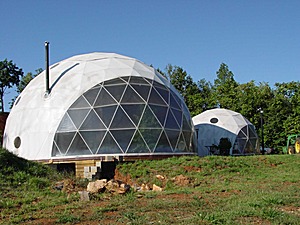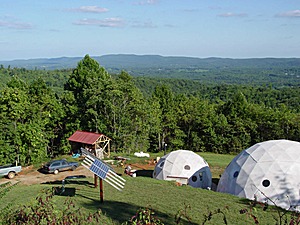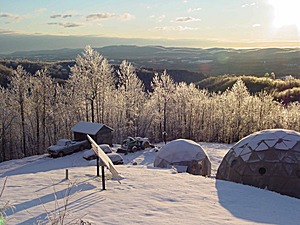
|
Geodesic Solitudewritten by Rene K. Mueller, Copyright (c) 2008, last updated Thu, March 27, 2008
Greg approached me by email in March 2008, and asked about technical details of one of the geodesic domes I calculated when I discovered he already lived in a geodesic dome, and took the chance to do a little interview with him by email (2008/03/18). All photos were kindly provided by Greg. How did you got into domes at all? We were looking to do an earth-bermed home, and it seemed the strongest of the possible choices for a given amount of material.
We were looking at a temporary home while we got together the money to put in the permanent, bermed house. And we did not want to live in a trailer. The Pacific Domes What models do you have (setup, cover, thermal insulation, custom extensions)?
The kit for both domes fit in the back of a full size pickup truck and was shipped to us in several bundles by United Parcel Service. We have a very scenic location for the dome, and our place has actually been used by Pacific Domes in their advertisements.
How about humidity, are your layers fully breathable? Humidity is not a problem except in the summer, since we do not produce enough energy to power a whole-house air conditioner. So the humidity is a comfort issue, not a physical problem. The house has enough air "leakage" that buildup of humidity or stale air is not a problem. That is, any breeze flexes the outer skin and makes the house "breathe" a little. We do have occasional drips in the winter when humidity from inside escapes and freezes on the inside of the outer skin at night, and then melts when the sun hits it in the morning. But that is really only in the one spot in the dome furthest from the wood stove. What is your overall experience with this approach (e.g. longlivity, water leakage, snow)? Occasional a few drops at the seams when it is very windy and rainy. Since the entire structure is "roof", heavy rain is fairly loud. How is your local climate (four seasons)? Here in southwest Virginia (36.8N,-79.8W) we have warm humid summers, usually no hotter than 35 degrees C, moderate winters with stretches of up to a week with below freezing temperatures, moderate snow, occasional ice. Since we have the land cleared away for best exposure of the solar panels, the dome gets a lot of sun. In the winter, temperatures inside the house on a sunny day are about 50 degrees F (28 C) warmer than the outside temperature without using the woodstove. In the summer, we open the windows and use a large fan to keep the inside temperature about the same as the outside temperature. Unfortunately, it is often too humid to take advantage of an evaporative cooler.
Supposed to last 10-15 years if properly cared for. I would have to figure out the cost of the skin separately from the structure to get a cost per year, and I do not have those numbers at hand. What kind of material is the outer skin? Heavy duty canvas. In our case, covered with a layer of elastic paint with ceramic particulates in it for abrasion, fire and UV resistance. I believe Pacific Domes has gone to a plastic/fabric combination of some kind on their current products. You spoke of producing energy, does it mean you are off-grid? Can you tell me a bit of your setup (heat, electricity, communication)? Solar panels for electricity (1.5kW), charging a 1000Ah 24 volt battery array, running through a Trace 4024 sinewave inverter for normal 120V/60Hz power. Backup generator. Propane tank for stove, clothes dryer and on-demand water heater. Woodstove for heat, auxiliary gas heater if needed. One of the photos shows the solar array as we originally put in. The racks are now full. I live remotely enough that my only internet access at the moment is through a low-speed dial up line. Have you ever done any maintenance on the dome in the past six years? We had a major hailstorm that damaged most of our windows a few years back and they had to be replaced. I used a wood sealing product on spots that need it, like our deck. The remnants of a hurricane came through a number of years ago and drove a branch through the skin of the dome, and that was sewn shut with needle and thread, and then sealed over with silicone caulk. Does it require a certain personality to live in a "one big room" of a dome with others, e.g. partners, as you have no real space to withdraw and be by your own? My wife and I enjoy each other's company. It is nice to be able to just look up from whatever you are doing and see the other person, or to ask something in a soft voice and have it carry, or put on some light music and be able to hear it anywhere in the house. Are there any regrets living in a dome? Nope. Well, it is hard to hang art from the inwardly curving walls. What would you do differently if you would start over? Not much. Any suggestions for people considering living in a dome as you do? You have to understand that it isn't a typical house. This has advantages and disadvantages. Ours is set up so that we have 6 meter ceilings and 12 meter line of sight for most of the commonly used areas. I can see from my office, the kitchen, the dining room, or the living room all the way across the house. Only private spaces and storage are enclosed. I would hate to go back to tiny rooms and low ceilings. Thanks Greg for the answers and the photos! Links
.:.
|
| Home | · | About | · |  Tipi | · |  Yurt | · |  Dome | · | Features | · | Gallery |

Creative Commons (CC) BY-SA-NC 2005-2017, developed, designed and written by René K. Müller
Graphics & illustrations made with Inkscape, Tgif, Gimp, PovRay, GD.pm
Web-Site powered by FreeBSD & Debian/Linux - 100% Open Source







